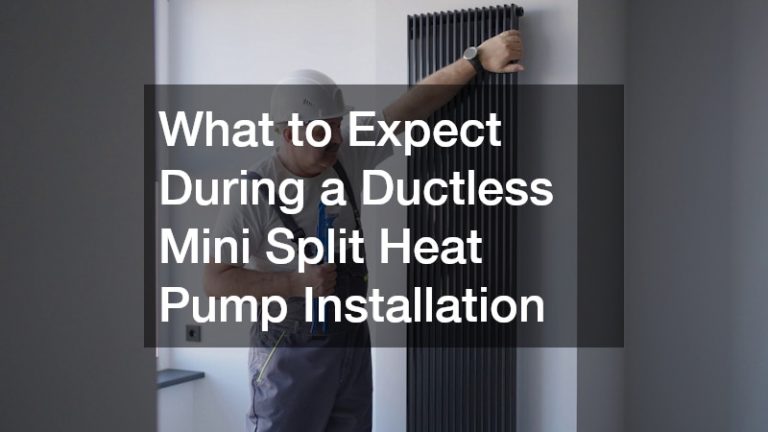Installing a ductless mini split heat pump can be a beneficial upgrade for your home, offering improved energy efficiency and comfort. Understanding the installation process can help you prepare and make informed decisions about your home improvement project. These systems are especially advantageous in homes without existing ductwork, providing a flexible and efficient alternative for climate control.
Choosing the Right Location
Choosing the optimal location for your indoor and outdoor units is crucial for efficiency and performance. The outdoor unit should be placed in a well-ventilated area away from direct sunlight and debris, to ensure it functions properly without any obstructions.
Indoors, it’s important to install the unit in a central location within the room to promote even air distribution, ideally away from heat sources or areas prone to drafts.
Your installer may recommend specific wall placements to maximize airflow and efficiency. It’s essential to ensure that the unit has enough clearance around it, both for installation and ongoing maintenance purposes. Additionally, locations near doors or windows can influence the system’s effectiveness, as these areas are more prone to temperature fluctuations
Understanding Installation Requirements
Understanding the requirements for installation ensures a smoother process and helps prevent unexpected issues. Space requirements for both indoor and outdoor units are vital, ensuring there is enough room for not only the installation itself but also adequate airflow. Additionally, the area should be free from moisture issues, as excess humidity can negatively impact the system’s performance and longevity.
Electrical needs are equally important, as these systems typically require a dedicated circuit to prevent overloading. Ensuring your electrical system can support the heat pump’s power requirements is crucial, and might involve upgrading your panel if it lacks sufficient capacity. Your installer can assist in assessing these needs and advising on any additional measures you may need to take.
Site Assessment and Preparation
Before installation begins, a thorough site assessment is conducted by the installers to determine the best placement and installation path. This assessment includes checking structural integrity, electrical sources, and ensuring the site is ready for the work to commence. Understanding any limitations ahead of time helps prevent delays and promotes a secure installation.
Preparation involves clearing any obstructions from the installation site to ensure efficient work flow. The installers may also set up barriers to protect surrounding areas from dust and debris, maintaining the cleanliness of your home during the process. Additionally, they will outline the specific placement details to ensure you are satisfied with the setup plan before proceeding.
Installation Timeline
The installation timeline typically initiates with pre-installation planning, ensuring every detail is accounted for. Most ductless mini split heat pump installation are completed within a day, depending on the complexity of the setup and any preparatory work required. This swift process includes mounting the units, running conduit lines for power and refrigerant, and configuring the system for use.
Steps in the timeline also include testing wiring and connections to ensure all components interact seamlessly. The thoroughness of these steps guarantees that your system functions efficiently and safely, preventing common operational issues. The installer will explain each stage, giving you an overview of the procedure and keeping you informed throughout.
Troubleshooting and Support
Even well-installed systems can occasionally encounter issues requiring troubleshooting. Common problems include unusual noises, reduced airflow, or temperature inconsistencies, often solved with basic checks such as ensuring settings are correct and filters are clean. However, more complex issues like refrigerant leaks should be handled by professionals to avoid damaging the system.
Having access to manufacturer support and guidance can be invaluable in troubleshooting, often providing solutions via customer service or official documentation. Noting any error codes displayed and relay them to support staff can speed up the resolution process. Additionally, installers often offer post-installation support, addressing any initial adjustments or concerns once the system is up and running.
For more complex issues, seeking professional repair services ensures problems are addressed efficiently and safely. Qualified technicians will have access to the necessary tools and expertise to diagnose and resolve issues accurately. Utilizing these resources assures peace of mind, knowing any operational hiccups will be promptly managed.
Energy Efficiency Benefits
The energy efficiency benefits of ductless mini split systems are among their biggest selling points. By eliminating duct losses, these systems can effectively reduce energy consumption compared to traditional HVAC systems. This efficiency translates into lower utility bills, offering a cost-effective solution for home climate control.
Advanced inverter technology allows mini splits to adjust output to match real-time demand, minimizing energy waste and enhancing comfort. With precise temperature control, you avoid the inefficiency of constantly cycling systems on and off. Additionally, the ability to control individual zones allows for targeted conditioning, ensuring energy is only used where it’s necessary.
Understanding the installation process and what to expect can help you enjoy the benefits of a ductless mini split heat pump with minimal disruption. Properly preparing for installation by considering placement, requirements, and communication with installers ensures a seamless setup. By maintaining your system with regular attention and utilizing professional assistance when needed, you can ensure it provides efficient and effective climate control for years to come.
.

